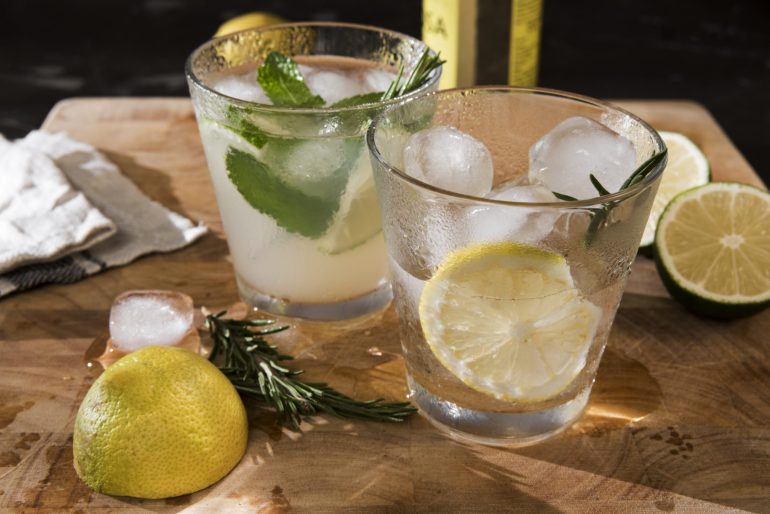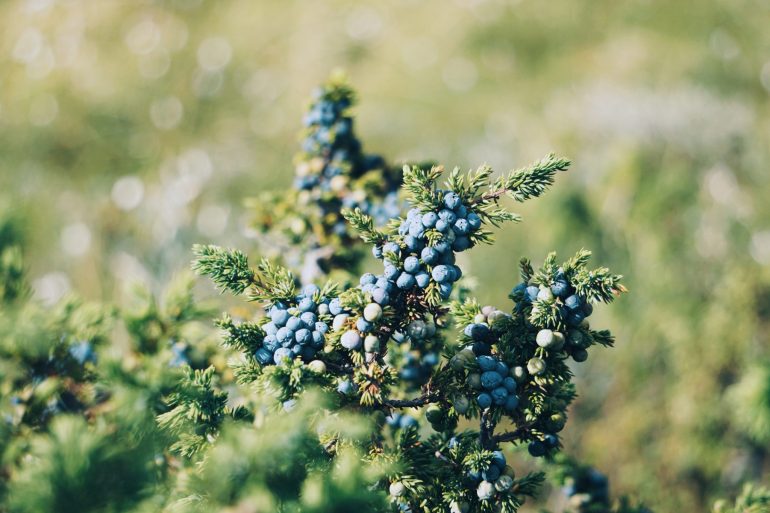Having experienced a resurgence in recent years, gin is trendy. This might be because of its versatility. Be it in a Martini, with tonic water or clean, the options are seemingly endless. It’s even used in cooking.
What’s more, this chameleon spirit is available in so many different strengths, flavours, and tastes, there is surely something to suit any palette. Whatever the reason, gin is officially in.
The key ingredient in gin is juniper berries, a fact hinted at by its name. This is thought to be derived from the Dutch word ‘genever’, meaning juniper. The question is, how is gin made? And how is pink gin made? Grab a glass and take a seat. The answers are right here.
Gin: A Short History
Before we discuss how gin is made, let’s delve into its history. It’s said that gin, in the form of fermented juniper, was used medicinally by Benedictine monks as early as the 13th century. However, it wasn’t until the late 17th century that it gained favour as a drink. It was also at this time that it was introduced in England.
It quickly became the drink of choice for many English aristocrats and, in the 18th century, a phenomenon known as the Gin Craze saw thousands of gin shops being opened around the country.
Gin continued to be popular in England throughout the following centuries. It was the key ingredient in many cocktails, such as the Gin Fizz and the Martini. Its popularity declined in the early 1900s, but it has since resurfaced as a trendy drink.
What is Gin?

Glasses of Gin & Tonic with lime, mint, rosemary and ice and with lemon (Photo: Westend61 via Getty Images)
Gin is a clear, distilled spirit that is flavoured with juniper berries and other botanicals. It is often used in cocktails and is a key ingredient in many classic cocktails, such as the Martini, Gimlet, and Tom Collins. There are many different styles of gin, from classic London dry to more modern craft gin. Each style has its own distinct flavour profile. For example:
- London dry gin: This classic style of gin is dry, juniper-forward, and very versatile.
- Old Tom gin: This style of gin is sweetened with sugar and has a distinctively rich flavour.
- New American gin: This style of gin is distilled with a variety of botanicals, resulting in a unique and complex flavour profile.
- Dutch gin: This style of gin is similar to London dry gin, but with a softer flavour.
- Scottish gin: This is distilled with malt, resulting in an earthier flavour, with a whisper of fruitiness.
So, how is gin produced? First let’s determine what’s in it.
How Gin is Made

Juniper berries (Photo: Merethe Svarstad Eeg / EyeEm via Getty Images )
There are many different styles of gin, all of which are made using different methods and recipes. As a general rule, to make gin the selected botanicals are infused in neutral grain alcohol and then distilled. This process allows the flavours of the botanicals to be extracted and concentrated in the final product. Here are the key steps in the process of how gin is produced today.
Ingredients
Gin is made from juniper berries and other botanical ingredients. There are many different brands and types of gin, but they all typically contain the same basic ingredients. By definition, gin contains juniper berries. Aside from this, the most common botanical ingredients in gin include:
- Coriander
- Angelica root
- Orris root
- Lemon peel
- Bitter almond
- Cassia bark
- Liquorice
- Grains of paradise
With the ingredients assembled, it’s time to see how gin is produced. The first step is to make a fermentable base.
Making the Base Liquor
A quality gin starts with a quality base. When considering how gin is manufactured, this can be achieved with either a grain or potato base. The base is what gives gin its distinct flavour and character. The process begins by mixing dried, prepared grains such as flaked maize and wheat malt with water and yeast. This creates what’s often called the ‘gin mash’, which is then heated and stirred.
Fermenting the Base
To produce a distilled alcoholic beverage with a high ethanol content, the base is placed in a vessel with Juniper berries and other botanicals. If using a grain base, the fermentation process will take about two weeks, whereas a potato base might take four.
Filtering
Fermented gin must be strained before it’s bottled. This helps to remove any sediment that may have formed during the fermentation process. First, it’s filtered through a strainer to remove any impurities. There are two methods of straining fermented gin: the cold method and the hot method.
The cold method is more common, as it’s less likely to damage the gin. It entails placing the gin in a container and refrigerating overnight. The next day, the gin is strained through a cheesecloth or coffee filter.
The hot method is more risky, as it can damage the gin if not done carefully. The gin is heated until it is just below boiling. Then, it’s placed in a container and put in the fridge overnight. Any solids are disposed of, leaving only the ethanol.
Distilling
Distillation is one of the most vital steps in answering ‘how is gin produced’. There are three distillation techniques that gin distillers use to purify their ethanol and infuse botanicals into the product:
- The pot still method
- The column still method
- The compound method
The pot still method is the most traditional method of distilling gin. The alcohol and botanical mixture is placed in a pot still and heated until the alcohol evaporates. The vapour is then condensed and collected.
The column still method is more modern. For this, the alcohol and botanical mixture is placed in a tall column still and heated from the bottom up. The vapour is then condensed and collected.
The compound method is a combination of the pot still and column still methods. In this process, the alcohol and botanical mixture is first distilled using the pot still method. The vapour from the pot still is then distilled a second time using the column still.
Batch Versus Continuous Distillation
Traditionally, gin has been produced in small batches. Nowadays, continuous distillation is an option in how gin is manufactured, whereby it is distilled in one continuous process. So what’s the difference between these two methods? Well, batch distillation allows for more control over the distillation process, while continuous distillation is more efficient. Additionally, batch distillation tends to produce a higher quality gin, while continuous distillation is more suitable for mass production.
Collecting the Liquid
The nature of the distilled liquid changes over the course of the process. The first distilled liquid to emerge, known as the foreshots, is of a lower quality. It’s either discarded or put aside to be redistilled. Next comes the heart or middle cut. The heart of any spirit, including gin, is the part that contains the most alcohol. This section is then blended with other parts of the distillate to create the final gin product. The last liquid to come out is the tails, or the feints, which are discarded.
Dilution
In gin production, it’s common to dilute distilled gin with water to reduce the alcohol content. This is done for various reasons, including to make the gin more palatable and to increase the yield. Gin that has been diluted with water is called “Cut Gin” and is typically between 35% and 40% alcohol by volume.
While some distillers add water after distillation, others do it before and it’s a matter of preference. This is because adding water to gin before distillation can help to extract more flavours from the botanicals. It’s also thought to produce a smoother finished product.
While diluting gin may seem like a simple process, there are some things to keep in mind. The type of water used, the proof of the gin, and the storage conditions can all affect the taste of the final drink.
There’s one more step before bottling the final product: quality testing of the colour, smell and the taste of the gin.
Bottling
Finally, it is time for the gin to be bottled. This might be done by hand or by an automated process. Once the bottles are filled, they are corked. Then, a plastic sleeve is applied and heated to shrink tightly over the bottleneck. Then adhesive labels are applied.
How is Pink Gin Made?

Pink gin at sunset (Photo: Allan Baxter via Getty Images)
So, we’ve looked at how gin is made, but how is pink gin made? If you’ve ever seen the attractively pink-hued beverage on supermarket shelves, you’ve probably wondered how it’s different from the clear variety.
There are in fact two forms of pink gin. The first is made by adding Angostura bitters to clear gin. Like other bitters, this is a concentrated alcoholic preparation made up of a mix of herbs, spices and gentian flowers.
The second type is sold as pink gin. The process of making this pink gin and traditional gin is the same up to and including distillation. It is after this stage that the gin is infused with the flavours and colours of bitters, spices or red fruits such as raspberries, strawberries, currants and rhubarb.
Explaining how Gin is Produced

Cheers! With Gin and Tonic (Photo: Instants via Getty Images)
So, we’ve learnt all about how gin is manufactured and that gin’s unique taste requires a thorough production process. How gin is made is as much a science as it is an art. We also answered ‘how is pink gin made’, revealing just how that pink hue is achieved.











